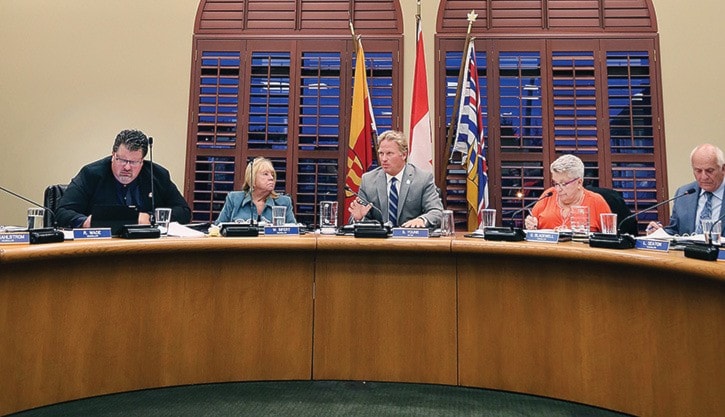Langford council this week listened to comments supporting and rejecting the City’s proposed request to remove 43 parcels of land – totalling more than 100 acres and mostly in south Langford – from the Agricultural Land Reserve.
Some of the 40 or so people who attended Tuesday’s public hearing on the block exclusion of the parcels spoke against the idea of allowing landowners to pay cash for the removal of their property from the ALR, or the way the City was going about the process. Others voiced approval based on the fact much of the lands was not suitable for agriculture.
This summer the City sent a letter asking landowners whether they would like their properties included in the collective exclusion and rezoning. Of the responses contained in this week’s council agenda, only one did not support having their property included in the joint application. Echoed by the tone at Tuesday’s meeting, there were a large number of letters and emails from Langford residents and others from all over the Island voicing their opposition to the application.
Langford resident Cheryl McLaughlin was among more than a dozen people who spoke to the issue Tuesday night. While she commended the goal of increasing agricultural production within city limits, she questioned “the rationale of removing land, which is the basis of agriculture, for money.”
McLaughlin noted the money would be a one-time benefit. “Once the money is gone, there is absolutely no recompense for the land that has been taken out. You cannot do agriculture without land. That’s the very basic idea behind the Agricultural Land Reserve.”
While she admitted a lot of ALR land in Langford is not currently in production, she said the protection of that land was vital for future generations and food security.
“You can always fix soil, you can fix drainage. You can’t fix the land once you don’t have it anymore.”
The municipality does not have the authority to remove land from the ALR; that decision rests solely with the Agricultural Land Commission (ALC).
Municipal councils have the right to veto a request for removal and refuse to forward it to the ALC, but Langford council has chosen not to use that right. As part of the exclusion hearing process, the ALC requires the City to hold a public hearing on the matter and forward a record of that hearing with council’s recommendation.
Some people speaking also offered suggestions for land use in areas that were not considered prime farm land that ranged from alternative crops like mushrooms to herbs. The debate of what was considered farmable and what really was the basis of agriculture was also approached.
At one point in the meeting Mayor Stew Young stopped to remind people what the hearing was about. “We’re not here to debate,” he said. “We’re having a public forum to hear what you are saying.”
Glen Willing and his brother, Peter, spoke in favour of the application. Their mother owns property that is included in the application and they said a portion of her property should be removed from the ALR because it is not tillable, which is a mandate of the ALC.
Willing said that when the ALR was originally established, a lot of properties were “broad brushed” and were included, some of which have never been farmed, he noted.
One property in the last application “should have had a sign on the front yard that said gravel pit.” He said that there was “absolutely zero arable land” and it should not have been included in the ALR.
Some residents raised concerns that their objections would have no influence in the process. Young assured them that all opinions voiced at the meeting were being recorded and would be forwarded to the ALC. “You have to hear both sides,” he said.
McLaughlin returned to the podium to question whether landowners or council initiated the process. Earlier in the meeting, another resident had stated that council had sent letters to property owners approximately 10 years ago asking if they needed assistance removing their properties from the ALR.
Coun. Lilian Szpak said the “ALC asked us to work with them on a strategy.” Szpak said the City is “working with their suggestions.”
Young said council came up with the idea of a block exclusion after a number of property owners had brought their concerns to them over a number of years. “’It’s not because Langford is pushing it. These are people in your community and your neighbourhood saying, ‘I’m not farming, why do I have to be broad-brushed with ALR?’”
The debate over who initiated the process was never definitively settled.
In 2007, C&F Land Resource Consultants Ltd. was contracted to prepare a report for the City. This report, called Agricultural Suitability Review for South Langford Neighbourhood Plan, was a preliminary assessment of the south Langford area to consider possible adjustments to the ALR boundary.
Some elements of that report were incorporated into the official community plan and the agricultural policy but for a number of reasons, especially the financial crisis in 2008, the proposal made in the report was not implemented.
Recently, the City asked to have the report revisited. Initially it was proposed that 111 acres be considered for exclusion based on factors ranging from property size to soil classifications. The revision suggested that 126 acres be considered for exclusion and featured a more in-depth soil report.
kengqvist@goldstreamgazette.com
